When you’re getting started the challenge is overcoming the fear of taking pictures of strangers. Since telephoto lenses are not normally used in street photography, how can you stand a few feet from your subject, put the camera to your eye, focus, and click the shutter without getting nervous? A good street photographer is not only fearful in the beginning (this is a good sign of being sensitive) but they also don’t want to do anything which will change the how the subject is behaving.
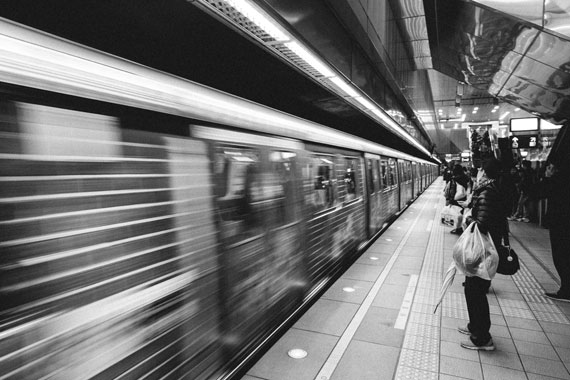
Photo captured by JC Gellidon; ISO 1250, f/5.6, 1/20s, 24mm.
With practice, you can overcome your reluctance to photograph strangers as well as learn techniques which will help you get better candid shots.
One word of caution – it can be addictive. After a while the street photographer will choose which seat has the best view in a restaurant, or which side of the street offers the best possibilities.
The Psychological and Moral Issues
The first thing to accept is that you are invading the privacy of your intended subject. You may have the best intentions in the world, but once you decide to point your camera at someone without their permission, you will be invading their personal space. This is what it means to take a candid street shot. Before going into the physical techniques which can make your job easier, it is important to look at your own motives. Most of the time, you see something that you simply want to share with the rest of the world. It might be funny, odd, mysterious, have an interesting design, or any other quality that you think is worth shooting. But you are nervous about taking the photograph. This is normal. When you are just starting out, ask yourself whether you would take the picture if you weren’t afraid of your imagined consequences. This may seem drastic, but pretend that this is your last day on earth, and that nothing else matters but getting this shot. Take a deep breath and after learning the various techniques listed below – you should be ready to get at it.
Dress the Part
You’ll be headed out to a tourist spot, so dress like a tourist. I’m not kidding. Although you may have lived in your city for 50 years, get yourself a tourist map and dress like you have just arrived from the mid-west on vacation. I’ll leave that part for you to figure out.
Visit a crowded tourist attraction where everyone has a camera. Dress and act as just another tourist. Study your tourist map. Gawk at the landmark like everyone else. And keep an eye out for interesting subjects.
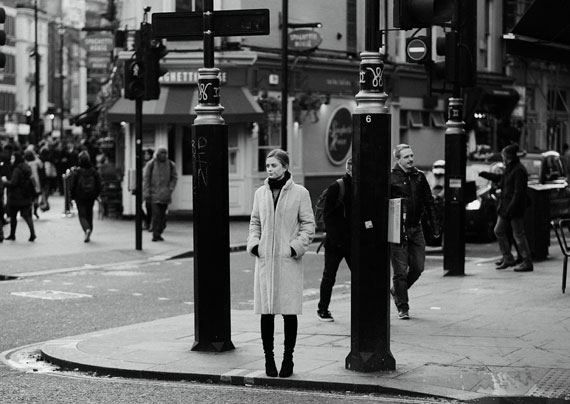
Photo captured by abi ismail; ISO 320, f/2.2, 1/640s, 85mm.
Do Not Remove Your Eye From the Camera After Your Shot
Start off like everyone else. Take pictures of the landmark. Keeping the camera to your eye you can now scan through the crowd for something interesting. As you take pictures, do not remove the camera from your eye even after you have the shot you wanted. Continue to move the camera around pretending to take pictures. Never give away the fact that you’ve taken someone’s picture by removing the camera from your eye after taking the shot.
You may not find anyone worth shooting, but this is an easy way to get started. It shouldn’t be very scary, and you will find that even while standing very close to your subjects you can take their pictures without arousing suspicion. You can employ the same techniques at street fairs, or parades. Just about any crowded area which is filled with tourists is a good place to practice.
Keep Both Eyes Open, Turn Off the LCD
Keep your non-shooting eye open. You should be able to look at possible subjects even with the camera to your eye. Most DSLR cameras have an LCD screen for viewing images on the back. This should always be turned off.
You just don’t want the LCD coming on while the camera is to your eye. It’s annoying and it gives away the fact that you’ve taken a shot, especially in a dark location. Also, if the LCD is off, and you hold the camera a bit in front of your face, you can see the reflection of what’s going on behind you.
Knowing what is happening behind you is useful in a street where people are moving around because you can estimate the distance the potential subject will be when you turn around, and have your camera pre-focused for that shot. Of course you’ll need to gauge how fast they’re walking towards you, and about where you’ll turn around and snap. But again – as you turn keep the camera to your eye as if you are just looking around. You will be surprised at how easy it is to take a picture of the subjects when they are five feet or so from you without them knowing.
Shooting from the Hip Vs. Having the Camera to Your Eye
As a general rule of street photography, if you can get the shot with the camera to your eye, you will get a better shot. I know that there is an entire school of shoot-from-the-hip photography, which you can practice as well, but you will never be able to frame this sort of shot as well as if you put the camera to your eye. (That’s my own opinion and of course open to debate.) There will be times when it is simply impossible to shoot with the camera to your eye, and so shooting from the hip is worth learning. But I don’t think it’s a good way to get started.
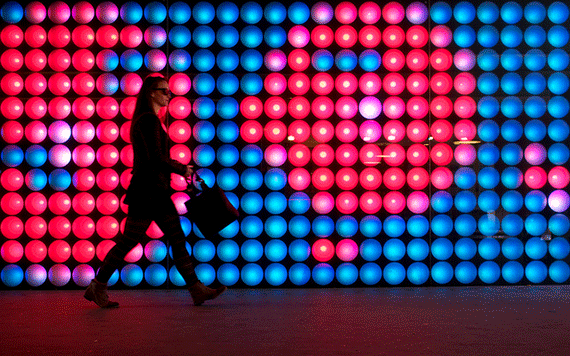
Photo by Thomas Leuthard; ISO 200, f/2.2, 1/125-second exposure.
You need to make decisions about depth-of-field. A common technique for the street photographer is relying on hyper-focal distance. I don’t think this is as necessary with modern auto-focus cameras, but the idea is that with a wide lens, in the 30 – 35mm range, you can set the lens to f8, if you have enough light, and set the focus at ten feet, and know that everything from approximately 6 feet to 15 feet will be in hyperfocal distance.(I’m not looking at a lens as I write this so the exact distance and f-stop may be off, plus most modern autofocus lenses don’t include a hyperfocal scale. But for older cameras with a hyperfocal scale on the lens, this is a tried and true technique.) I just haven’t found it to be necessary with modern auto-focus cameras.
Pre-Focus
For example, with the Canon and Nikon DSLRs you can assign focus lock to a button on the back of the camera and exposure to the shutter button. You anticipate that you are going to shoot a certain subject, and hold the back button down to focus on them, but maybe you aren’t ready to take their picture yet and they aren’t moving much. You can continue to hold that back button down until you are ready to take the shot, or you can turn the lens to manual focus while holding the button down. Then you can release the button and know that the focus remains the same. Don’t forget to turn autofocus on the lens back on when you’re finished or all your subsequent shots will be out of focus.
Modern cameras have a matrix of focal points. They are a big selling point. But they are not very useful for street photography. I would recommend turning them all off except for the center focal point, which you’ll use to pre-focus with. I don’t like the idea of having the camera decide what to focus on.
Suppose you’re walking down a New York street and you see a bunch of subjects leaning against the building to your right. You know that you are going to turn and face them at take your picture and then walk on. So the distance between you and any building directly to your right is the same. You focus on a building to your right before you arrive at your subjects and lock that focus. Now as you approach your subjects, you turn to your right and take your shot without the need to focus.
Having a Friend Along
This technique goes back a long way in the history of street photography. Walker Evans would bring a woman friend along with him, and stand on a crowded street pretending to take pictures of her. She was a decoy, and he would move the camera so that she wasn’t in frame and take pictures of the people that behind her.
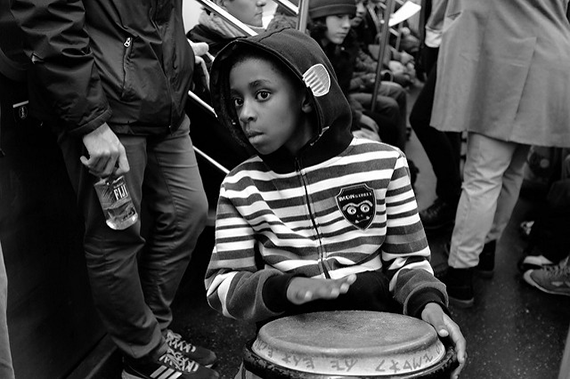
Photo by B.C. Lorio; ISO 400, f/2.8, 1/110-second exposure.
Gadgets
Sneaky camera gadgets have been around for a 100 years. The right-angle attachment on the viewfinder was often used by famous street photographers. It can swivel at various right-angles so that you are looking in a different direction than where the lens is pointed.
A similar device that fits on the end of the lens has a mirror inside. The front of the lens is points straight ahead, but the mirror is pointing to your left or right.
Both gadgets are still made, but they take some getting used to. I haven’t found them necessary, although I’ve experimented with both devices.
Tougher Locations
The subway car is another popular locale for street photographers.
When Walker Evans did his series of subway “portraits,” he used a Rollei Twin Lens camera. You look down at the ground glass to focus and compose. Evans used a cable release which he ran up the arm of his coat. He put the camera on his lap, sat directly across from his subject, and kept his right hand in his pocket to operate the cable release.
He knew ahead of time, what the distance was too his subject. If you are shooting on the same subway line, the trains are always the same dimensions. If you don’t have a camera with auto-focus, you know the distance between different points.
Evans had one problem with his setup. After taking his shot, it was very obvious that he was advancing the film to the next frame. He would usually get up and settle down in another car with a new frame loaded.
Although the subway is a difficult place to shoot, it has one advantage: it’s noisy. There’s always enough noise to drown out the click of the shutter. I have taken thousands of pictures on the subway with the camera to my eye without running into any sort of trouble other than the occasional nasty stare. However, before the camera is raised to your eye it should already be focused. This rule is true for most street shots.
You can focus on your subject when they aren’t looking, set the camera lens to manual and wait for “the moment” if it ever happens.
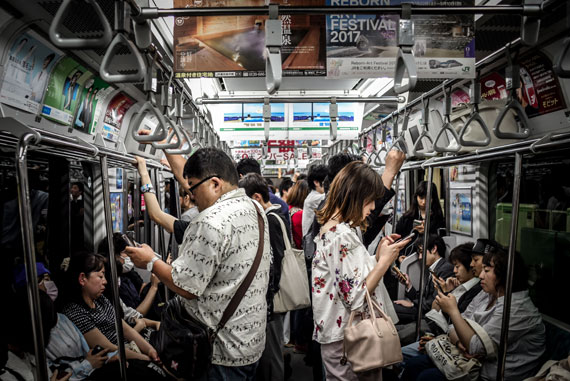
Photo captured by Hugh Han; ISO 1000, f/2.8, 1/200s, 28mm.
Whether on a train, or some other location, the easiest time to shoot is when there is a distraction. For example, when the mariachi band enters the car, everyone will be looking at them. You can shoot other passengers without being noticed.
And even if you are seen, people will understand that you have your camera out if you take a few shots of the mariachi Band as well. This is the same technique as using a landmark as a reason for taking pictures.
Another modern phenomena which makes life easier for the street photographer: everyone, whether on the street or in a subway car, is already distracted by their iPods, cell phones, e-books, and Blackberry devices. One day I was on the train, and noticed that everyone around me had earphones, or were reading their email. Combined with the noise of the train, I was able to take closeup shots of a passenger who was about a foot and a half away from me without being noticed by anyone. I found that amazing. It wasn’t like that ten years ago.
Shutter Speed
As a rule for hand-held shooting, your shutter speed should equal the focal length of your lens. If you shoot with a 30mm lens, your shutter speed should be at least 1/30th of a second. If your shoot with a 90mm lens, your shutter speed should be at least 1/90th of a second to prevent blur due to camera shake.
Some photographers can hand-hold a camera at 1/15th of a second with a 30mm lens and some will have trouble holding the camera steady enough even at 1/30th of a second with a 30mm lens. So this is just a guide. Camera shake is also a property of the camera. An SLR camera, with the slap of the returning mirror, vibrates more than a Point and Shoot camera which doesn’t have a mirror. Many Digital SLRs now feature “Live Mode” where the mirror slap is no longer a factor. So you will need to experiment to find out the lens / shutter speed combination which will prevent camera shake with your setup.
But remember this, camera shake is not the same thing as motion blur. Even if your camera is set on a tripod, with a mirror lock-up, and a cable release, if the motion of the subject is too fast for your shutter speed, you will have a perfectly blur free background (no camera shake) with a blurred subject.
I call this technique The Stutter Step. The object of the stutter step is to be able to freeze your walk, in mid-step if needed, at the same instant you click the shutter, and then continue on as if nothing has happened. If you do it slowly, someone walking briskly behind you may just about bump into you because you have stopped dead in your tracks for an instant while you put the camera to your eye and took a picture of someone walking towards you. For this sort of shooting, where your subject(s) more directly towards you, it is best to have as fast a shutter speed as you can manage.
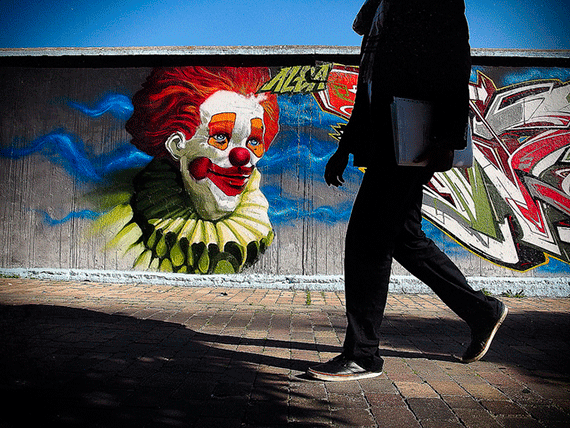
Photo by Miguel Moya; ISO 200, f/5.0. 1/1000-second exposure.
Digital SLR cameras usually have the following settings: P (program mode), AV (aperture mode), TV (shutter speed mode) and M (manual mode). They also have a a bunch of icons representing other situations such as Action Mode, or Portrait Mode, or Night Mode. Don’t use these. Again, you don’t want the camera to make decisions for you.
But it is handy, to set your AV and TV modes so that with the twist of the dial, you are set for aperture or shutter speed priority. In the case where it is a sunny day and you are walking, and expect to be taking pictures of other people who are walking, you can work in TV mode, with your shutter set to 1/1000th of a second. This assumes that you are using a relatively fast lens, and that you can shoot at an ASA (ISO) of at least 800.
But to return to the stutter step. Your camera is hanging around your neck. You are wearing tourist clothes. You see an interesting situation developing ahead of you. Your camera is set to shutter priority of 1/1000th (more if you can manage it), and you must image what distance you will be when you take the shot. Aim your camera at the sidewalk and focus at the distance that you imagine you’ll take your shot and lock that focus in.
Now, just when the situation is right, you halt, sometimes in mid-stride, the camera moves to your eye. You already know whether this is going to be a vertical shot or not, and what the frame will be, and while you are stock still, you take your shot and just as if nothing happened, you continue on your way. Your subjects have passed you. Even if they noticed you, it is unlikely they will turn back to find out why you may have just taken their picture. Maybe you did, and maybe you didn’t.
Which Camera?
A good street camera has the following characteristics: a quiet shutter, interchangeable lenses, fast lenses (F-Stop of F2.0 or lower), no shutter lag, RAW capture mode, the ability to focus well in dark places, usable high ASA, a good viewfinder and lightweight enough to take with you wherever you go. I don’t know of any digital Point and Shoot camera that meets all these criteria. A digital Single Lens Reflex (DSLR) will meet all or most of these properties. The Canon 40D, for example is no heavier than a Leica M, but the fast lenses are larger. The high end Point and Shoot, known as a digicam, has some of these features, but they don’t have interchangeable lenses, and the zoom lenses are not usually faster than F2.8 at the wide end.
The current crop of DSLRs have many features of a good street camera.
So, let’s get to it. Whatever digital camera you use, turn off any beeping the camera makes. Also turn off the immediate playback on the LCD. Do some tests to find out that highest ASA you can use without getting too much digital noise. Again, this is where DSLRs are best. Cameras like the Canon Mark II can allow you to use an ASA as high as 3200 (maybe more) without creating much digital noise in the image. Most point and shoot digital cameras creating noiseless images at much about 200 ASA.
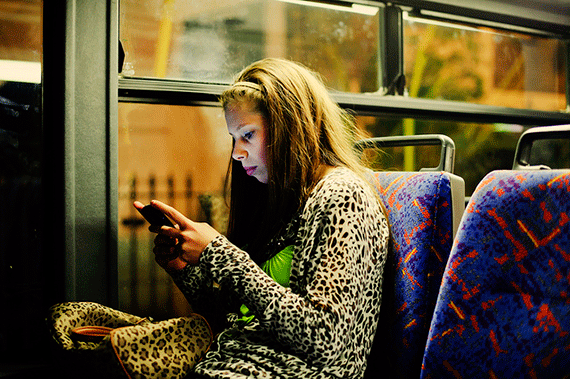
Photo by Chris JL; ISO 3200, f/2.0, 1/80-second exposure.
Most DSLRs depend on a tic-tac-toe matrix of focal points. Keep the center point on, and turn the other focal points off.
For a digital camera with a cropped sensor, a 30mm F1.4 is a good walking around lens. Sigma makes an excellent one though remember, the Sigma f1.4 30mm won’t work with a full-frame sensor). If you are using a full-sized sensor, then a 35mm f1.4 lens, in combination with a 50mm f1.4 is an excellent combination. Having a lens that gives you a good quality shot at F1.4 is very important. And just because a lens opens to F1.4 doesn’t mean that it’s good at that F-Stop, so pick this lens carefully. In the Canon line, the 50mm F1.4 which is for a full sensor, and which works with a cropped-sensor as well, is one of their best lenses and compared to their other F1.4 lenses is cheap.
A DSLR usually has a method for decoupling the exposure from the focal point. It’s a good idea to do this. The Canon 40D and in fact almost all Canon SLRs (going back to the film days) have this feature. You set the focus lock to a button on the back of the camera, and a half-press of the shutter locks exposure. I dwell on this idea because many times you are going to use the button on the back to pre-focus your shot, and do framing as the camera comes to your eye. The idea that you want the camera to take it’s exposure off the focal point doesn’t make much sense. In general, if you are relying on the meter, than it’s better to lock focus, and have the meter do a general reading of what’s in the frame.
Whether it’s a sunny day, or an overcast day – ASA 800 is a good place to start. You almost always want all the shutter speed you can get. If your camera produces very noisy images at ASA 800 than it is not the right camera to use.
Never use a lens cap. Not at any time, for any reason. You should always have a UV filter on the lens, which will protect the lens and make it easy to take a quick shot. You can always tell an amateur if they are using a lens cap.
The Benefit of High ASA
One benefit of modern cameras is the ability to shoot at a high ASA. You may be able to set your walking around shutter speed at 1/4000th of a second, with an ASA of 1600. Some of the newer cameras have usable ASA ratings of 32,000 and higher without causing noise in the RAW image. This opens up a new world to street photographers. With a high ASA you can shoot with a high F-Stop and a fast shutter speed in low light situations like the subway. For example you could use an F11 f-stop with a 1/1000th of a second shutter speed, and still have enough light for a proper exposure on the subway. That is a new development in street shooting.
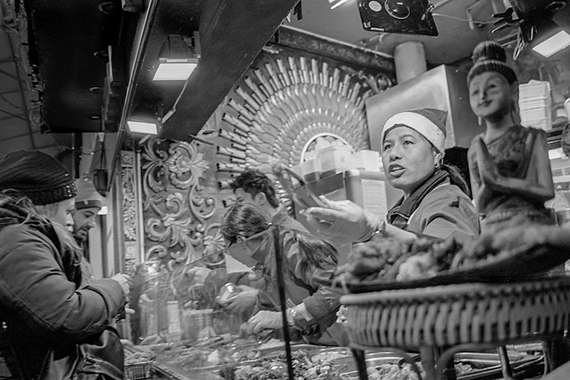
Photo by Dennis Freeland
Previously, street photographers would push their film or use fast film for shooting. They might use an ASA of 1600 or more, but the resulting negatives would be grainy. As I write this, the Canon Mark II can easily shoot at 1600 ASA with results similar or better than 400 ASA black and white film.
Don’t Throw Anything Away
No matter how you try, and no matter how good your street technique is, most of your shots will be ordinary. You might come back after a day of shooting with nothing to show for it. You may feel non-productive.
Street photography is like fishing. If you enjoy fishing, the catch is important, but the entire experience of getting up early, and making many fruitless casts from your boat isn’t non-productive. You may enjoy the experience whether you return with fish or not. You simply can’t cast your rod and expect to catch a fish every time.
Your best street catches make up for all the uninteresting shots. Unlike fishing, you can’t always tell immediately if you’ve caught a great shot. Many street photographers will let their captures sit for a while before looking at them. What this means is: don’t throw anything away. Make backups of your images, and even if you think they’re not very good – don’t toss them. Given the inability to describe what makes a good street shot, you shouldn’t throw any away. Even an out-of-focus shot might have something interesting in it when you have enough distance to judge it. Your may find something in a shot that seems boring when you look at it again a few years later. This has happened to me enough times so that I never delete digital images.
The Oblivious People
Street Photography is easier then it used to be. People in the city walk around with their senses clogged up. More people are oblivious to what is going on around them than ever before. Music is blasting in their ears, or they’re talking on their cellphone. If they’re not talking on the phone they may walk the streets while reading their email. This makes it easier to photograph a stranger without them noticing you.
Street photography is harder than it used to be. Since we live in an age of urban terrorism and web postings, people and the police are more suspicious than ever. This suspicion extends to landmarks and property. The subways and the streets are filled with video cameras watching your every move. While you take your photographs, most likely you too are being photographed. In New York all major infrastructure contains signs banning photography.
In New York, although it is legal to take pictures on the subway, there is the possibility that you’ll be questioned by the police who think you may be a terrorist. Maybe they don’t know the current laws. You are allowed to photograph on the subway, so long as you don’t use a flash or tripod. However, it is always a good idea to have valid ID with you in case you are stopped. I have been stopped many times while photographing on the subway and usually I just explain that I’m a fine art photographer, working in black and white, and show some ID and that’s enough. If you are going to use a flash, or a tripod, it is still possible to get a permit to photograph in a specific location in the subway.
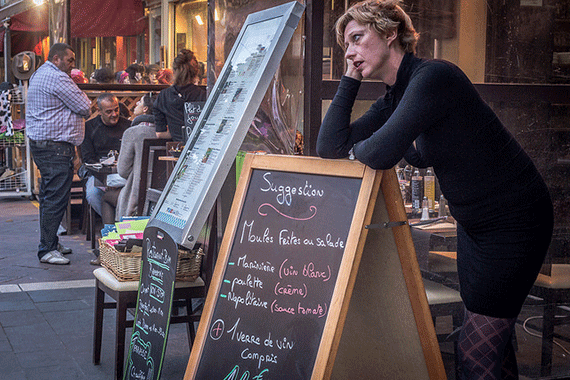
Photo by Roberto Borello
Asking Permission
Photographers who are starting out want to know if it’s a good idea to ask permission from your subject. It would be nice if you could, but it isn’t practical. Once you strike up a conversation with your subject, you are no longer doing street photography. From that point on, the person will strike a pose, and you will be doing what I call street portraits. Should you get a model release? Unless you are doing street portraits, it isn’t practical. On any given day, you may take 100 images only to find one good one (if you’re lucky). It would be impossible to ask each person you photograph to sign a release Many of your shots are of people that rush by you in a fraction of a second.
What to do if you are Caught
At some point, you will be caught, and your subject will approach you. Maybe they say, “Did you just take my picture.”
Honesty is the best policy. The answer is, “yes.” You smile, and try and explain what it was that you found so interesting about them. With a digital camera, you can show the image on the back of the camera. The person may then be annoyed, or they may be flattered. If they are upset, and the picture isn’t that great, then you could offer to delete it for them – and don’t play any tricks. Delete it while they watch. If it’s a great shot and you want to keep it, then you’ll have to win them over. If you were using a film camera you could just shrug it off and say “no.” But everyone knows that you could just show the picture on the back of the digital camera.
Most of the time the person is flattered and wants to know if you would like to take another shot. At this point they almost always strike a pose, and you take the picture knowing that you won’t use it. You aren’t a war correspondent. Very few images are worth getting into a big hassle over. In all my years of shooting, the worst that’s ever happened is that someone asked if I would please delete their photo. I think this happened twice out of ten thousand shots.
Summary
- Choose an easy locale with lots of tourists when you are first starting out.
- Turn off any beeping your camera does.
- If you photographing individuals in a crowd, don’t remove the camera from your eye after you take a shot, but keep scanning the crowd with it.
- Turn off the instant playback on the digital LCD
- Use a wide to normal lens. Don’t rely on telephoto lenses
- Make sure that you are focused and know how you are going to frame the image before the camera goes to your eye.
- Only shoot from the hip, or without looking through the viewfinder as a last resort.
- Practice looking for specific literal ideas: irony, juxtaposition, design elements, joy, sadness, emotional moments, things that you find unusual, surprises.

Photo by Roberto Borello
- Be prepared to take a hundred shots for every good one. And try and understand what a good shot means. (This is outside the scope of this article).
- Always have a camera with you. You’ll take some of your best pictures during your normal daily routines.
- Know the laws. You don’t need to get into a big hassle with the police when they stop you from taking pictures in a place where you know it’s legal to take pictures; but it’s important to know your rights.
- Do not ask for permission or a model release, unless you are doing “portrait” work on the streets. Do not expect that you’re images will be usable for print ads unless the subject is not recognizable (profile, shot from the back etc.)
- If you are afraid to put the camera to your eye – try to imagine that this is your last day on earth, and that the shot you see before you will be great. In other words, you may need to psych yourself into taking the shot. But there is a balance and if it really is too scary – then don’t force yourself. Your own fear will come across to the subject. When to shoot, and when not to push it, is something you’ll learn with time.
- Never use a lens cap (have an UV filter on the lens instead)
- Remember that no matter how many of these techniques you use, you are still invading someone’s privacy. There is no way around that. So you must feel that what you are photographing is worth the effort.
And finally, give yourself time to get used to the experience. Expect to be nervous in the beginning. Also expect that after you’ve been at it for a few years these techniques will become second nature. I think that being nervous is actually a good sign. Anyone with some degree of empathy will be uncomfortable doing street photography in the beginning. If you are the type of photographer that begins by sticking your camera in the faces of strangers, it is doubtful whether you are sensitive enough to be a good street photographer.
About the Author:
Dave Beckerman, a professional photographer in New York for over 10 years. Before that, it was an avocation.
Like This Article?
Don't Miss The Next One!
Join over 100,000 photographers of all experience levels who receive our free photography tips and articles to stay current:






This was really a good post. loved it
This article is superb. so knowledgable. Keep up the good work. :)
Clearly lying when you say the worst that has happened is you were asked to delete a shot. I have been attack verbally and physically for taking people’s pictures in public. “I want money” “you owe me money for my picture” “why are you taking my picture” “you are stealing my image” are uncommon but events that happen at least weekly in street photography. It is part of the process. You need to wear running shoes to run away when people turn violent. And they will. Never engage with people if they seem angry. It will get a lot worse better to walk away fast.
This hands down is the best article on street photography do’s and don’ts that I have read to date. I am an aspiring street photographer and will put to the test the many valuable tips that you have written down. I will be using a nikon d810 with 35mm 1.8g/50mm 1.8 g lenses. I have briefly tried the “f8 and be there” mantra at a parade in my hometown. I was using the 35mm, and the pictures came out stunning. The pictures got even clearer when I cropped the. I couldn’t believe it. Tack Sharp! I’m gonna do my next test in NYC…should be interesting…..Thanks for the tips;good job!
Thank you for this article. I learned a lot as a street photography beginner.
Thanks for all this tips really useful!
Mahdi
http://www.mahdiaridjphotography.com/galerie/street-photography:
Particularly liked the last paragraph. (the rest was good too!)
Any tips on shooting through peepholes in hotel room doors?
This is one of the best pieces I have come across on the fundamentals of street photography. If you start here and go out on the street and practice you are on your way. Good luck.
A few good basic pointers here but overall but this article could really have used an editor. Couple of examples:
• “ASA” – a standard that was replaced by ISO in the late 1970s.
• Reciprocal handheld rule of thumb – came about with film cameras, inappropriate for cameras with smaller sensors.
• “you are invading the privacy of your intended subject” – define your terms. “Invade” means what exactly? And what privacy are you conferring onto people walking in public, and at what distance?
• Bring a friend to run interference as you sneak around. Dumb suggestion, one that Beckerman himself does not use.
• You need interchangeable lenses. No you don’t.
Meh article with occasional decent tips.
A very comprehensive guide to street photography!
Great article! I was wondering, now with the internet and social media etc,what would happen if someone saw their image online.Surely if you had not obtained permission to take or use the picture, the person could cause trouble if they saw their picture online??
My thoughts EXACTLY!! Legally speaking, should the use of such images generate income for the photographer the subjects could sue the photog if/when they discover the use of their image or likeness without consent. I believe there is only established precedent regarding “street” images containing multiple subjects in the frame within a public place. Still, even then…… those subjects could sue & request monetary compensation. A major hassle to deal with. So snap away but be aware that when it comes to use of a likeness things get messy QUICK!!!
I’m an aspiring photographer and I actually gain a whole lot by reading this ……
Nice Article.
Today, first day. Just trying the lightening of my camera (I haven’t used it for looong).
Second shot, I was focusing on some advertisement fixed on a tree. A child, maybe 6 years olds come and tell me :
“Excuse me, sir ?
– Yeah ?
– You shouldn’t stalk people. It’s bad. You haven’t the right to do it.
– Well I actually am taking the picture of… a tree.
– You haven’t the right to stalk.
– Okay, thanks.”
I stay a totally surprised, and I just left. While lefting, he gone to his mother and told “he took the picture ! He took the picture !” as if I have robbed something…
Really embarassing. So I even haven’t taken the second shoot. I “disappeared” and been out of the city for doing some landscape pictures…
First day, second shoot… I must be lucky…
Thanks for a highly informative article.
does anyone know what I do if I have shots with members of the public in that I want to publish in a book?
I didnt get a model release at the time, so whats the legal position on this?
Dave,
Thanks for posting my photo and your comments. I must say, your tips are very helpful and I hope to see more of your short articles and tips in the near future.
Thanks for the article and the tips. I learn something new every day. I have never tried street photography but after reading this I may have to give it a try.
Dave,
Thanks for sharing these tips. I found them most helpful as I just started with photography as a hobby and like to carry my camera with me and capture anything that catches my eye. I will going to start implementing these tips next time I go out with camera.
keep up the good work :)
Joseph
Very good article, with myself a street photographer, but with time you get along and not to scared
Absolutely wonderful article, Dave. It’s great to read about how other street photographers work. I love the idea of using a “decoy”– you have to have a very patient Significant Other for this to work! I half-agree with you about not deleting shots. I too have found shots that I was originally ambivalent about but that seem great a year later. But I throw away shots that I’m 100% sure are just junk. Otherwise I couldn’t cope with the clutter and all the tagging that Lightroom requires.
Easily the most useful article on the topic I’ve read in the past year. Simple ideas to make street shooting faster and more efficient. And therefore less intrusive. Thanks.
Thanks for the great article! While not new to photography, street photography has only been the occasional shots, and yes, they sometimes create awkward situations – invading personal spaces etc. The article not only had great tips on techniques for getting those shots, but also some valuable technical info. Super!
This is a fantastic article to get someone started in street photography. Very well written and covers all key points.
Wow. Fantastic article, definitely inspires me to go practice street photography! Thanks so much for the helpful tips too! I NEVER would have thought to turn off the LCD playback! Please continue to write articles!
I have faced many problems with street photography. I am a beginner and get veryyyyyy scared in streets, markets, public places. Many times I unzip chain of my camera case but don’t bring camera out from the case because of the same fears you mentioned above.
I really liked this article and have made it my bookmark as I need to read it so many times, especially when I am planning to go out for photography. Thanks for this lovely and well written post. But I am still scared. I think things will get better with experience and practicing the tips you have suggested. Thanks again.
This is the best article I´ve read so far. Why? ´cos it´s like a tutorial and it´s a very long article to read which I like a lot!
So keep it up!
Tom
an enlightening and well written article content